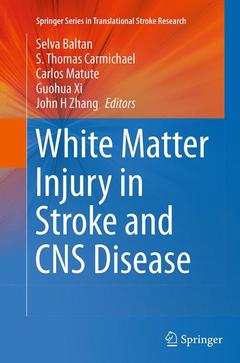Description
White Matter Injury in Stroke and CNS Disease, 2014
Springer Series in Translational Stroke Research Series, Vol. 4
Coordinators: Baltan Selva, Carmichael S. Thomas, Matute Carlos, Xi Guohua, Zhang John H
Language: English
Subject for White Matter Injury in Stroke and CNS Disease:
Keywords
Publication date: 08-2016
Support: Print on demand
Publication date: 11-2013
592 p. · 15.5x23.5 cm · Hardback
Description
/li>Contents
/li>Biography
/li>Comment
/li>
1 White matter: Basic principles of axonal organization and function
Alexander A Velumian and Marina Samoilova
2 Electrophysiology evaluation of white matter injury
Mingke Song, Anna Woodbury, Shanping Yu
3 CADASIL and animal models
Francesco Blasi, PharmD, PhD, Anand Viswanathan, MD, PhD Cenk Ayata, MD
4 Neuroimaging of White Matter Injury: A Multimodal Approach to Vascular Disease
Gary A. Rosenberg, Branko Huisa, Fakhreya Y. Jalal, Yi Yang
5 Diffusion MRI Biomarkers of White Matter Damage in Traumatic Brain Injury
Maria Ly, Samuel Ji, Michael A. Yassa
Section II: White Matter Injury in Stroke and other CNS Disorders
6 Mechanisms underlying the selective vulnerability of developing white matter
Paul A. Rosenberg
7 Neonatal experimental white matter injury
Zhengwei Cai
8 Focal ischemic white matter injury in experimental models
Robert Fern
9 Global ischemic white matter injury in patients
Shinichi Nakao, Yan Xu
10 Experimental global ischemia and white matter injury
Ji Hae Seo, Kazuhide Hayakawa, Nobukazu Miyamoto, Takakuni Maki, Loc-Duyen, Eng H. Lo, Ken Arai
11 White Matter Injury after Experimental Intracerebral Hemorrhage
Kenneth R. Wagner
12 White Matter Repair after Ischemic Injury
Elif G Sӧzmen, S. Thomas Carmichael
13 White Matter Injury in Subarachnoid Hemorrhage in Humans
Gian Marco De Marchis, MD and Stephan A. Mayer, MD
14 Neurodegenerative diseases and white matter injury in patients
George Bartzokis, M.D., Po H. Lu, Psy.D
15 Unmyelinated and myelinated axons exhibit differential injury and treatment response following traumatic brain injury
Thomas M. Reeves, Adele E. Doperalski, Linda L. Phillips
16 Age-Dependent Mechanisms Of White Matter Injury After Stroke
Selva Baltan
17 White matter damage in multiple sclerosis
María Victoria Sánchez-Gómez, Fernando Pérez-Cerdá, Carlos Matute
Section III: Pathophysiology of White Matter Injury
18 Calcium dyshomeostasis in white matter injury
Elena Alberdi, Asier Ruiz, Carlos Matute
19 Inflammation and white matter injury in animal models of ischemic stroke
Lyanne C. Schlichter, Sarah Hutchings, Starlee Lively
20 Oxidative stress in white matter injury
Hideyuki Yoshioka, Takuma Wakai, Hiroyuki Kinouchi, Pak H Chan
21 Acute Axonal Injury in White Matter Stroke
Jason D. Hinman, S. Thomas Carmichael
Section IV Other white matter injuries
22 Mitochondria disorder and white matter injury
R. Anne Stetler, PhD, Rehana K. Leak, PhD, Zheng Jing, PhD, Xiaoming Hu, PhD, Yanqin Gao, MD, Guodong Cao, PhD, and Jun Chen, MD
23 Heave metal and white matter injury
Yang V. Li
24 Anesthesia and white matter injury
Phillip Vlisides, Zhongcong Xie
Selva Baltan, MD, PhD is an Associate Professor of Molecular Medicine at the Department of Neurosciences at the Cleveland Clinic. Her research focuses on mechanisms of brain cell damage following stroke in white matter in a region-specific and age-specific manner. Currently she is interested in the role of protein acetylation and mitochondrial dynamics in white matter stroke which has expanded her interests to neurodegenerative diseases such as Multiple Sclerosis and Alzheimer’s disease that involve white matter.
S. Thomas (Tom) Carmichael is a neurologist and neuroscientist in the Department of Neurology at the David Geffen School of Medicine at UCLA. Dr. Carmichael is Professor and Vice Chair in the Department, with active laboratory and clinical interests in stroke and neurorehabilitation and how the brain repairs from injury. He received his M.D. and Ph.D. degrees from Washington University School of Medicine in 1993 and 1994, and completed a Neurology residency at Washington University School of Medicine, serving as Chief Resident in 1997-1998. Dr. Carmichael was a Howard Hughes Medical Institute postdoctoral fellow at UCLA from 1998-2001, studying mechanisms of axonal sprouting, with a clinical emphasis on neurorehabilitation and stroke. He has been on the UCLA faculty since 2001. Dr. Carmichael’s laboratory studies the molecular and cellular mechanisms of neural repair after stroke and other forms of brain injury. This research focuses on the processes of axonal sprouting and neural stem cell and progenitor responses after stroke, and on neural stem cell transplantation. Dr. Carmichael is an attending physician on the Neurorehabilitation and Stroke clinical services at UCLA.
Dr. Carmichael has published important papers on stroke recovery that have defined mechanisms of plasticity and repair. These findings include the fact that the stroke produces stunned circuits that limit recovery, but can be restored to normal functioning wi
Provides systematic expert summaries of normal white matter morphology
Details white matter injury following stroke and other CNS injuries
Contains key notes and implementation advice from the experts




